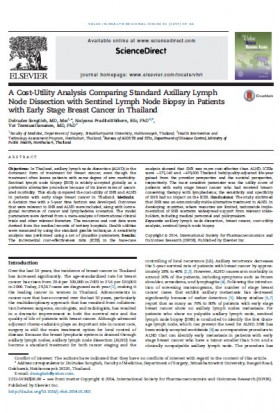This website uses cookies so that we can provide you with the best user experience possible. Cookie information is stored in your browser and performs functions such as recognising you when you return to our website and helping our team to understand which sections of the website you find most interesting and useful.
A Cost-Utility Analysis Comparing Standard Axillary Lymph Node Dissection with Sentinel Lymph Node Biopsy in Patients with Early Stage Breast Cancer in Thailand (2014)

Details
Abstract
Objectives
In Thailand, axillary lymph node dissection (ALND) is the dominant form of treatment for breast cancer, even though the treatment often leaves patients with some degree of arm morbidity. Sentinel lymph node biopsy (SNB) is widely accepted globally as a preferable alternative procedure because of its lower rates of associated morbidity. This study compared the cost-utility of SNB and ALND in patients with early stage breast cancer in Thailand.
Methods
A decision tree with a 5-year time horizon was developed. Outcomes that were relevant to SNB and ALND were included, along with locoregional recurrence of cancer and lymphedema scenarios. The model parameters were derived from a meta-analysis of international clinical trials and other relevant literature. The resources and cost data were derived from the medical records of tertiary hospitals. Health utilities were measured by using the standard gamble technique. A sensitivity analysis was performed using a set of plausible parameters.
Results
The incremental cost-effectiveness ratio (ICER) in the base-case analysis showed that SNB was more cost-effective than ALND. ICERs were −275,140 and −470,600 Thailand baht/quality-adjusted life-year gained from the provider perspective and the societal perspective, respectively. The most sensitive parameter was the utility score of patients with early stage breast cancer who had received breast-conserving therapy with lymphedema; the sensitivity and specificity of SNB had no impact on the ICER.
Conclusions
The study confirmed that SNB was an economically viable alternative treatment to ALND. In developing countries, where resources are limited, nationwide implementation of SNB warrants widespread support from relevant stakeholders, including medical personnel and policymakers.
Please click here to access the paper. http://www.sciencedirect.com/science/article/pii/S2212109914000041




